The MYC-LR3576 System-On-Module (SOM), with its compact size of 43mm x 45mm, delivers exceptional reliability for your upcoming embedded design projects. Powered by the robust Rockchip RK3576 application processor, it boasts a quad-core Cortex-A72 and a quad-core Cortex-A53, an integrated 6 TOPS NPU, and a 3D GPU. The RK3576 supports various video codecs, including up to 8K@30fps or 4K@120fps decoding (H.265/VP9/AVS2/AV1) and up to 4K@60fps encoding (H.265/H.264), ensuring users can experience high-quality video playback and recording. In addition to the RK3576 CPU, the MYC-LR3576 SOM integrates 4GB/8GB LPDDR4X and 32GB/64GB eMMC on board. It provides a range of peripherals and IO signals via a 381-pin expansion interface with an LGA package. It also supports for Linux and Debian OS. With its high-performance and low-power design, this feature-packed SOM is suitable for scenarios such as industrial, AIoT, edge computing, smart mobile terminals, and many other digital multimedia applications.

MYC-LR3576 System-On-Module (Top-view and Bottom-view)
The MYC-LR3576 supports Linux 6.1, Debian 12 and Android operating systems, ensuring flexibility and adaptability for various project requirements. MYIR provides a comprehensive software bundle, including kernel and driver source codes, along with compilation tools, to facilitate a smooth development process from initial design to final implementation.
The MYD-LR3576 Development Board serves as a comprehensive evaluation platform specially designed for the RK3576. It features the MYC-LR3576 SOM at its core and offers a wide range of peripheral interfaces on its base board, including two USB 3.0 interfaces, one USB 2.0 interface, dual Gigabit Ethernet interfaces, two CAN interfaces, and one integrated WiFi/Bluetooth module. Furthermore, it incorporates a Micro SD card slot and an M.2 NVMe SSD-compatible PCIe slot. The board also features a diverse set of multimedia interfaces, such as HDMI, DP, and MIPI-DSI display interfaces, along with three MIPI-CSI video input interface and audio capabilities. Moreover, the board offers flexibility for expansion through various peripheral signals accessible via the RPI Interface (GPIO/I2C/UART/SPI/CAN-FD) and the MiFAN Interface (GPIO/I2C/UART/SPI/USB), allowing users to customize and enhance their development experience.
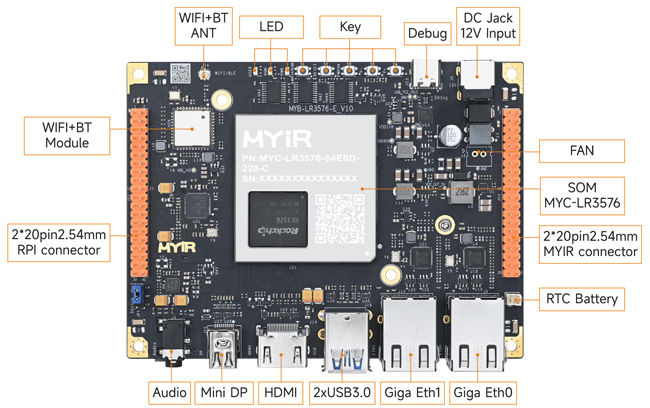
MYD-LR3576 Development Board (Top-view)

MYD-LR3576 Development Board (Bottom-view)
The MYD-LR3576 comes bundled with one 12V/3A power adapter, one USB Type-C cable, one WiFi/Bluetooth antenna and one quick start guide. Additionally, MYIR offers optional add-on modules for this product, such as the MY-CAM003M MIPI Camera Module, MY-CAM004M 4AHD-to-MIPI Camera Module, MY-CAM005M MIPI Camera Module, and MY-MIPI101C 10.1-inch LCD Module. The MYD-LR3576 offers a kit MYD-LR3576J-GK with the RK3576J CPU version includes an expansion board MY-ICEB001 that extends three USB2.0 ports, one RS232 port, two RS485 port, two CAN interfaces and one M.2 Socket for a USB-based 4G/5G LTE Module with a SIM card holder. These additions significantly expand the board's functionality, providing users with versatile capabilities to cater to their unique project needs.
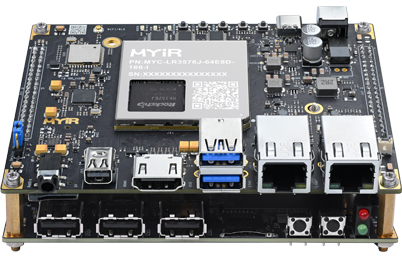
MYD-LR3576 (RK3576J version) with an expansion board MY-ICEB001
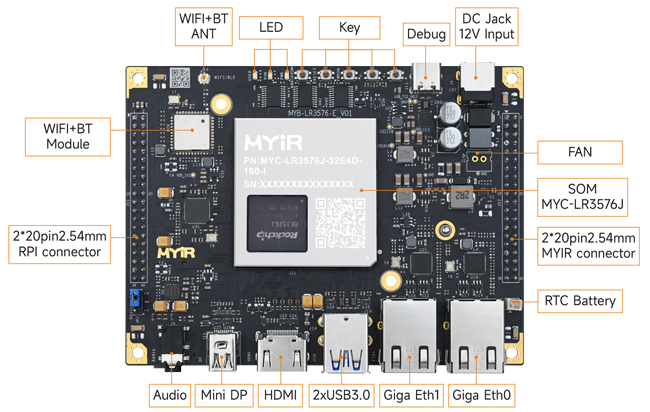
Top-view of MYD-LR3576 Development Board (RK3576J version)
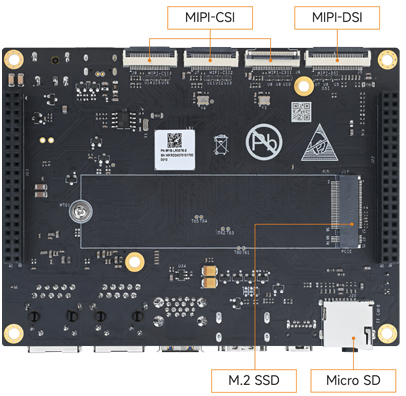
Bottom-view of MYD-LR3576 Development Board (RK3576J version)
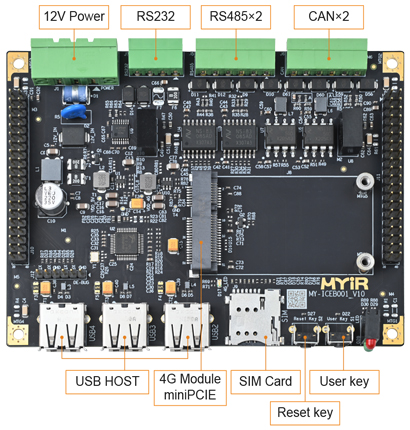
MY-ICEB001 Expansion Board (provided exclusively for MYD-LR3576 with RK3576J version)
Features
Mechanical Parameters
-
Dimensions: 43mm x 45mm
-
PCB Layers: 12-layer design
-
Power supply: 5V/3A
-
Working temperature: 0~70 Celsius (commercial grade, with RK3576 CPU)
or -40~85 Celsius (industrial grade, with RK3576J CPU)
Processor
-
Rockchip RK3576 / RK3576J processor
- Octa-core Arm processor with 4x Cortex-A72 cores at 2.2 GHz, 4x Cortex-A53 cores at 1.8 GHz
- Arm Cortex-M0 MCU at 400MHz for user application
- Arm Mali-G52 MC3 GPU
- 6 TOPS NPU supports INT4/8/16/FP16/BF16/TF32
- Supports up to 8K@30fps or 4K@120fps video decoding (H.265/HEVC, VP9, AVS2, and AV1) and video encoder up to 4K@60fps video encoding (H.265 and H.264)
Memory and Storage
-
4GB/8GB LPDDR4X
-
32GB/64GB eMMC
-
32Kbit EEPROM
Peripherals and Signals Routed to Pins
-
381-pin LGA expansion interface
- 2x RGMII/RMII
- 1x USB/DP combo, USB3.2 OTG
- Multi-PHY (1-lane PCIe2.1 or SATA3.1, 1-lane PCIe2.1/SATA3.1/USB3.2)
- SD v3.0/MMC v4.5.1, 4-bit
- SDIO v3.0, 4-bit
- 1x FSPI, 1/2/4-bit data width
- DSMC/FlexBus, 8/16-bit data width
- 12x UART, up to 8Mbps, auto flow control (except UART0)
- 2x CAN/CANFD
- 10x I2C
- 2x I3C
- 16x PWM
- 5x SPI
- 6x SARADC, 12-bit
- 1x MIPI-CSI D-PHY v2.0, 4-lane, 4.5Gbps/ C-PHY v1.1, 3 trios, 2.5Gbps
- 1x MIPI-CSI D-PHY v1.2, 2*4-lane/4*2-lane/4+2*2, 2.5Gbps
- 1x DVP, 8/10/12/16-bit, BT.601/BT.656 and BT.1120
- 1x ISP, 16M pixels
- 1x HDMI/eDP Combo interface (supports 4K@120fps/4K@60fps)
- 1x USB/DP Combo interface (supports 4K@120fps)
- 1x MIPI-DSI, up to 2560x1600@60Hz
- 1x Parallel output interface, supports RGB/BT.656/BT.1120, 1080p@60fps
- 2x I2S/TDM/PCM, 4-channel
- 3x I2S/TDM/PCM, 1-channel
- 2x SPDIF TX, 2x SPDIF RX
- 2x PDM, 8-channel
- Up to 152x GPIOs
Note: the peripheral signals brought out to the expansion interface are listed in maximum number. Some signals are reused. Please refer to the processor datasheet and SOM pin-out description file.
OS Support
-
Linux 6.1
-
Debian 12
-
Android 14
|